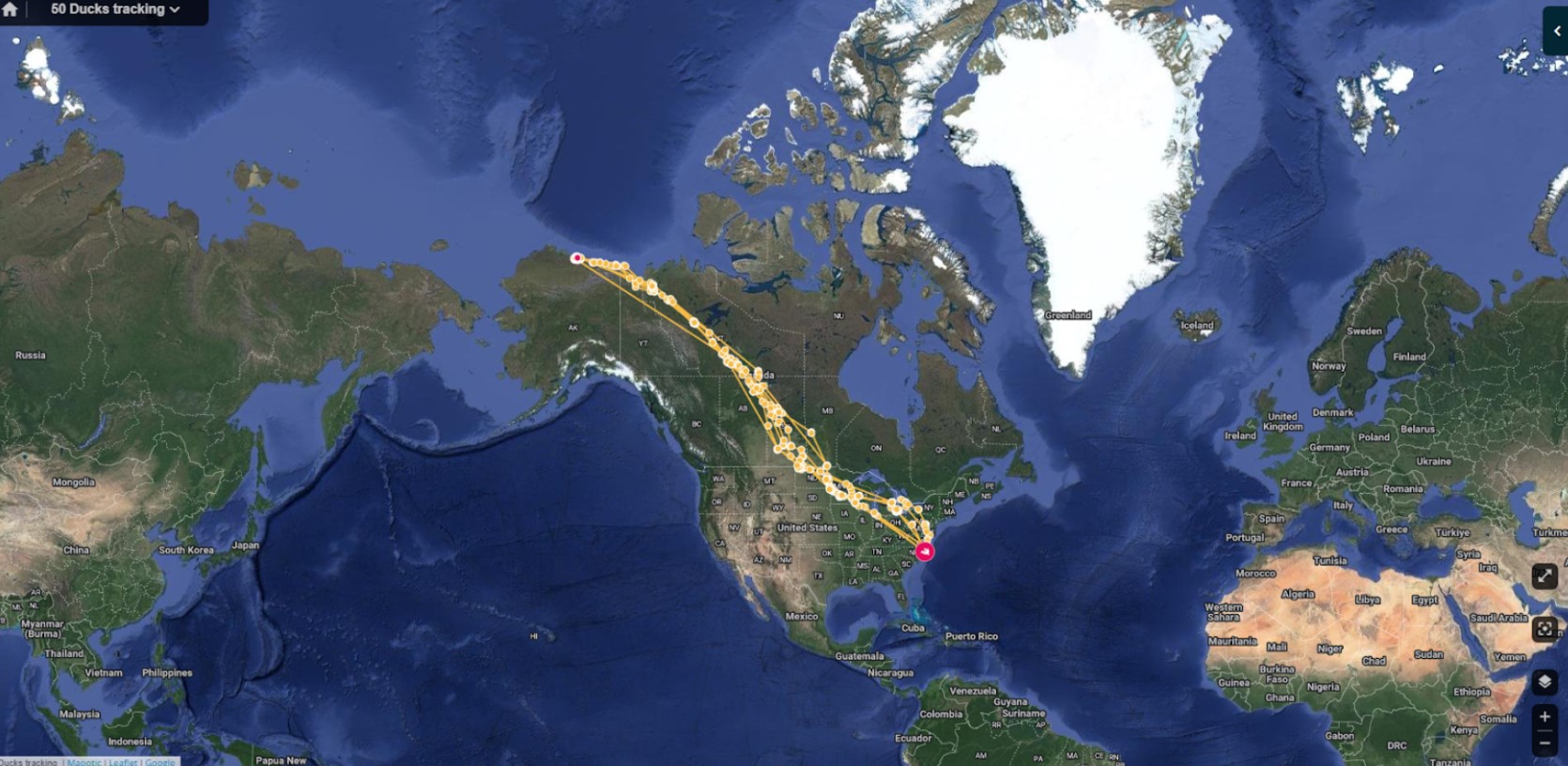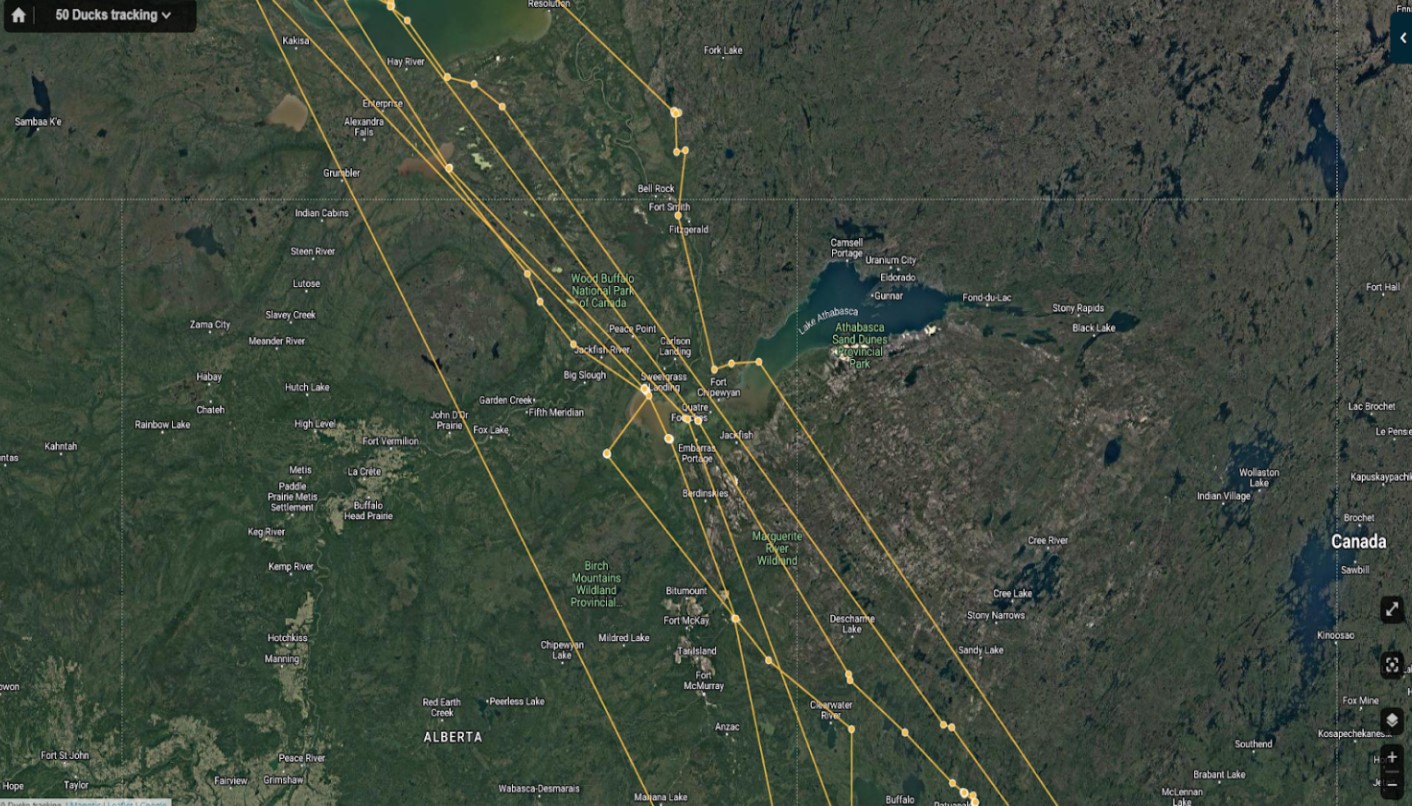Avian Adventures: A Tale of Tundra Swans and Canada Geese
Greer Smith
July 22, 2024

50 Ducks continues its mission to study and highlight the migratory patterns of birds, captivating an ever-growing audience with our innovative tracking platform.
Today, we dig deeper into the incredible journeys of two Tundra Swans and the male Canada Goose. These feathered voyagers traverse thousands of miles, demonstrating the resilience and adaptability of waterfowl as they make their annual treks to breed and survive.
Here are some notable insights into their fascinating flights to provide a broader perspective while celebrating the beauty of nature’s migration tales.
Instinctual Precision: The Journey of Tundra Swan #38
Nature’s brilliance shines through in the journey of Tundra Swan #38, banded in the remote, pristine region of Alpine, Alaska, along the Arctic Ocean. Over four migration cycles from 2008 to 2011, this swan traveled an impressive 30,741.5 miles, showcasing its incredible navigational skills and resilience.

Migration Details
Tundra Swan #38’s migration began each year with a departure from Alpine, Alaska, heading toward the serene waters of Phelps Lake on the North Carolina coast, approximately 130 miles east of Raleigh. This vast distance of 3,550 miles took the swan across diverse landscapes, demonstrating the intricate patterns of avian migration.

Along the way, Lake Athabasca in Northeast Alberta is a pivotal stopover, although #38 never lingered there for more than three days. This consistent behavior highlights the swan’s precise migratory habits, known as philopatry, where birds return to their birthplace or specific nesting sites year after year.

Patterns and Technology
The role of GPS tagging in tracking our whistling swan’s journey cannot be overstated. Early transmitters, like the Argos tag used on this swan, transmitted location data in four-hour bursts before conserving energy for four days. Despite these limitations, valuable insights into its migration routes and behaviors were revealed.
One of the most remarkable feats recorded was between May 10th and 14th, 2010. During that period, Tundra Swan #38 covered an astounding 1,079.2 miles. This achievement highlights the endurance and navigational instincts of these magnificent birds.
Potential Benefits For Tomorrow
Tracking the journey of a whistling swan is an educational adventure for students. Learning about migration patterns and preservation sparks interest in future generations. This passion spills over to birdwatchers, conservationists, and scientists seeking to protect migratory pathways and the ecosystems that support them.
Waterfowl Realities: Insights from the Male Canada Goose
Canada Goose #22 captivates with its extraordinary migratory patterns and adaptable behavior. Tagged in Chicago, this gander journeyed 1,456 miles to the pristine wilderness north of Hudson Bay. Despite such extensive travels, data revealed that a mere 1.16% of its life was spent in flight, underscoring the importance of ground activities in waterfowl ecology.
Natural Interactions in Various Settings
Urban environments played a significant role in Canada Goose #22’s life. Regular sightings at Milwaukee’s Whitnall Golf Course during the fall of 2016 highlighted the bird’s remarkable tolerance to cold weather and the ability to thrive in urban settings.
However, during the breeding season, this gander displayed an incredible fidelity to a single square mile area in Rankin Inlet. Such consistency emphasized the critical need for preserving specific habitats essential for survival and reproduction.
The life of Canada Goose #22 challenges common misconceptions about waterfowl behavior. While many imagine these birds constantly in flight, the reality is that much of their time is spent navigating both urban and natural landscapes. This behavior showcases the adaptability and resilience of these birds, capable of finding resources and thriving despite human encroachment.
Potential Impacts
Tracking data from 50 Ducks provides invaluable insights into these patterns, aiding researchers and enthusiasts in developing effective conservation strategies. The story of our male Canada Goose underscores the need to protect migratory pathways and critical habitats.
By studying the data and ground activities of #22, we gain extensive knowledge that reinforces the need for collective action in conservation efforts.
The Adult Tundra Swan: From Arctic Waters to the Golden Gate
Migration Details
Astonishing feats of endurance and navigation define the journey of Tundra Swan #30, a true exemplar of avian resilience. Over 1,296 days, our pen swan traversed an awe-inspiring 26,253.9 miles, charting a path from the icy waters of Sheshalik, Alaska, to the sunlit expanses of California’s Sacramento Valley. Each voyage highlighted its annual stop at the Great Salt Lake, a critical waypoint in its extensive migration.
Tundra Swan #30’s itineraries were meticulously tracked using ARGOS technology, which logged 5-10 locations every three days before entering a battery-saving hibernation mode. This early tracking technology revealed the extraordinary distances covered and offered profound insights into the swan’s migratory patterns and behaviors.
Research Insights
Contrary to initial hypotheses, research indicated that the length of migration had no significant impact on the swans’ survival or reproductive success. This finding reshapes our understanding of these majestic birds.
One of the more remarkable achievements occurred between April 26 and 29. This pen swan showcased endurance and navigational prowess over an incredible 1,304.5-mile distance in just three days. Vast wildernesses and diverse ecosystems were no match as it navigated its route with impressive precision.
New Perspectives
For birdwatchers, data collectors, and conservationists, the journey of the adult Tundra Swan offers valuable lessons. Each leg of its migration informs broader conservation strategies, emphasizing the need to protect critical stopover sites and wintering grounds.
By studying these patterns, we gain insights that aid in preserving the swans and the ecosystems they depend on. At 50 Ducks, we celebrate these stories through real-time GPS tracking, bringing the incredible journeys of waterfowl like Tundra Swan #30 to life.
Final Thoughts
With revealing observations and data, Tundra Swan #38, Canada Goose #22, and Tundra Swan #30 offer profound insights into these incredible birds’ resilience and migratory prowess. Technological advancements like ARGOS tracking have revolutionized our understanding, allowing us to uncover detailed patterns and behaviors that inform critical conservation efforts.
Educational resources on our platform provide valuable tools for schools, researchers, and bird enthusiasts, fostering a deeper appreciation for whistling swans, ganders, and ducks. Our partnerships with conservation groups such as Tierra de Aves A.C., Jack Miner Sanctuary, and the Environmental Resource Network underscore our commitment to preserving these species.
Join us at 50 Ducks to monitor ducks, the male Canada Goose, and pen swans historical tracks and iin near real-time. We encourage you to familiarize yourself with our home page, duck map, and historic tracker to become part of this exciting journey. Together, let’s support conservation and celebrate the wonder of waterfowl migrations. Start tracking today for a better tomorrow!
